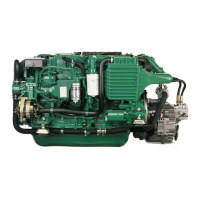Do you have a question about the Volvo Penta KAMD43 and is the answer not in the manual?
Manual's purpose, warning symbols, and general safety guidelines.
Safety for hot oil, water, ventilation, chemicals, and fuel leaks.
Safety for electrical systems, lifting, general installation, fuel quality, and potential hazards.
Safety for engine room planning, immobilization, running engines, turbochargers, starting spray, and coolant.
Lists and describes essential tools for installation.
Factors for engine choice, performance needs, limitations, power, and gear ratios.
Guidelines for engine room layout, weight distribution, fuel, cooling, exhaust, and electrical systems.
Principles of propeller design and the process of selecting the correct propeller.
Maximum permitted engine inclination and how to check it.
Importance of weight distribution and engine center distance for twin installations.
Ensuring accessibility for maintenance and repairs of the engine.
Types of engine suspension and benefits of flexible mounting.
Recommended combinations for engine suspension and propeller shafting.
Using the engine as a fixture to determine engine bed position and construction.
Procedure for drilling mounting holes for engine suspension.
Considerations for selecting propeller shaft material, size, and strength.
Determining shaft dimensions and bearing distances using diagrams.
Procedures for installing and aligning the propeller shaft and bearings.
Steps for installing extra equipment and accessories before engine installation.
Procedures for placing the engine onto the engine bed and ensuring correct alignment.
Adjusting engine mounts for height, sideways movement, and loading.
Checking flange alignment and installing V-drive rubber mounts.
Guidelines for careful fuel system installation, sealing, and fire safety.
Guidelines for fuel tank location, installation, venting, and material.
Guidelines for routing and clamping fuel lines (rubber and copper).
General procedure for measuring fuel feed pressure on all engines.
Dimensioning, materials, and general installation advice for cooling systems.
Installation of sea-water intakes, cocks, strainers, and pumps.
Recommended coolant mixture ratios and filling process.
Importance and installation of engine heaters for service life.
Comprehensive information on wet exhaust line installation and components.
Consequences of excessive backpressure and acceptable limits in exhaust lines.
Procedure for measuring exhaust backpressure using a manometer or water column.
Planning electrical installations and battery terminology.
Guidelines for connecting batteries for voltage or capacity increase.
Step-by-step instructions for setting the code on a universal tachometer.
Checks before launching, including batteries, valves, and propellers.
Checks before starting the engine for alignment, leaks, and systems.
Instrument checks, leak checks, and engine speed verification during test runs.
Checks for engine room temperature, noise, vibrations, and controls across speed ranges.
Manual's purpose, warning symbols, and general safety guidelines.
Safety for hot oil, water, ventilation, chemicals, and fuel leaks.
Safety for electrical systems, lifting, general installation, fuel quality, and potential hazards.
Safety for engine room planning, immobilization, running engines, turbochargers, starting spray, and coolant.
Lists and describes essential tools for installation.
Factors for engine choice, performance needs, limitations, power, and gear ratios.
Guidelines for engine room layout, weight distribution, fuel, cooling, exhaust, and electrical systems.
Principles of propeller design and the process of selecting the correct propeller.
Maximum permitted engine inclination and how to check it.
Importance of weight distribution and engine center distance for twin installations.
Ensuring accessibility for maintenance and repairs of the engine.
Types of engine suspension and benefits of flexible mounting.
Recommended combinations for engine suspension and propeller shafting.
Using the engine as a fixture to determine engine bed position and construction.
Procedure for drilling mounting holes for engine suspension.
Considerations for selecting propeller shaft material, size, and strength.
Determining shaft dimensions and bearing distances using diagrams.
Procedures for installing and aligning the propeller shaft and bearings.
Steps for installing extra equipment and accessories before engine installation.
Procedures for placing the engine onto the engine bed and ensuring correct alignment.
Adjusting engine mounts for height, sideways movement, and loading.
Checking flange alignment and installing V-drive rubber mounts.
Guidelines for careful fuel system installation, sealing, and fire safety.
Guidelines for fuel tank location, installation, venting, and material.
Guidelines for routing and clamping fuel lines (rubber and copper).
General procedure for measuring fuel feed pressure on all engines.
Dimensioning, materials, and general installation advice for cooling systems.
Installation of sea-water intakes, cocks, strainers, and pumps.
Recommended coolant mixture ratios and filling process.
Importance and installation of engine heaters for service life.
Comprehensive information on wet exhaust line installation and components.
Consequences of excessive backpressure and acceptable limits in exhaust lines.
Procedure for measuring exhaust backpressure using a manometer or water column.
Planning electrical installations and battery terminology.
Guidelines for connecting batteries for voltage or capacity increase.
Step-by-step instructions for setting the code on a universal tachometer.
Checks before launching, including batteries, valves, and propellers.
Checks before starting the engine for alignment, leaks, and systems.
Instrument checks, leak checks, and engine speed verification during test runs.
Checks for engine room temperature, noise, vibrations, and controls across speed ranges.
| Brand | Volvo Penta |
|---|---|
| Model | KAMD43 |
| Category | Engine |
| Language | English |











